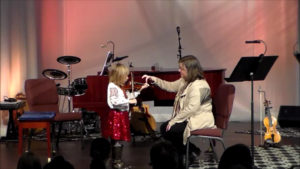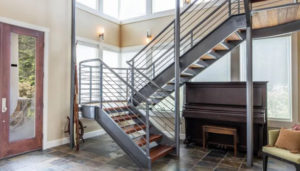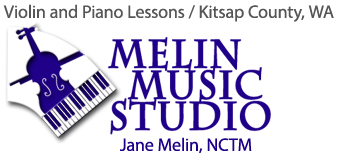Early-Learner Readiness
 Learning to play the violin involves multiple fine-motor skills, reading or pre-reading activities (I teach even young beginners the building blocks to reading music) and the ability to persevere even when encountering frustrations. The piano is a little easier to play at first — no out-of-tune notes or scratchy sounds — but still requires concentration and patience. So when parents ask me about music lessons for young children, ages 6 and below, there are a few things I look for before committing to teaching them.
Learning to play the violin involves multiple fine-motor skills, reading or pre-reading activities (I teach even young beginners the building blocks to reading music) and the ability to persevere even when encountering frustrations. The piano is a little easier to play at first — no out-of-tune notes or scratchy sounds — but still requires concentration and patience. So when parents ask me about music lessons for young children, ages 6 and below, there are a few things I look for before committing to teaching them.
First, I’m looking for a child who is independently motivated to learn to play the instrument — and able to focus during a 30-minute lesson period and for at least 10 minutes at a time when practicing. I do break up lessons with different activities for the youngest students to help “get the wiggles out,” but have found that focus is the single biggest contributor to success at the younger ages.
Right-Left distinction (for hands, and directions on a keyboard) is required. Early reading and math skills are also necessary.
Reading skills needed:
- Know alphabet letters A-G by sight and memory. Even better if child can say them backwards!
- Understand “Decoding”: that printed symbols on a page have meaning and give directions. For example: Letter “M” is called “Em”, has the sound “Mmmm” and is used in words like “Mom.”
- Related to Decoding is Tracking: Following printed symbols left-to-right.
Math skills needed:
- Counting to 10 and recognizing all digits 1-9.
- Rudimentary addition and subtraction. 1+1=2; 3 – 2 = 1.
- Understanding how cutting one object into several equal pieces (like a pizza) creates parts with names that are simple fractions: one-half, one-quarter or one-fourth etc.
A natural ear for music or innate desire to play their instrument is really important too. If a young child struggles or becomes frustrated with fine-motor activities or has a short attention span, they probably need to wait a year or two to begin lessons. In the meantime, encouragement to sing or pick out tunes on a keyboard is a great place to start!
Finally, parental involvement is crucial. For beginning students under age 8, I ask their parent or caregiver to observe their lesson and help them with their practice time each day. This is the only way to ensure that the correct playing position is maintained to avoid learning bad habits (see below). The parent may also need to help the child read their assignment notes and complete all practice tasks, track written music left-to-right at first, play notes in tune (on violin), etc. The students with the most involved parents are the ones who progress fastest!
Music Learning Objectives
To learn to play a musical instrument, students must be trained in three distinct but related functional areas: the MIND, the MUSCLES and the EARS.
MIND: Decoding printed notations and producing the sounds they indicate with the instrument uses the entire brain! Students are constantly striving to understand and follow rhythm patterns, relative note positions, finger placements and note naming conventions (collectively called “Music Theory”). More advanced students will learn to interpret complex music notation, including phrasing, dynamics, tempos, fingerings and (on violin) bowings. It’s no secret that students with early and ongoing musical training tend to excel in math and language subject areas in school!
MUSCLES: Learning to hold and manipulate the violin and bow is not easy. Just as an athlete must constantly pay attention to the correct physical form and movements for their sport, repetition of correct positions and movements with the violin is the only way to train our MUSCLES to automatically provide the right responses every time. Any new or existing poor habits of posture, finger/hand/arm positions and playing technique must be adjusted so new pathways can be learned and correctly stored in “Muscle Memory.”
Piano students learn the correct hand/arm/wrist/finger positions, how to incorporate pedaling with their fingering, and how to play the instrument without looking at where their fingers are landing (playing by touch).
EARS: A violinist must listen to every note he/she produces to see if each one is in tune, immediately adjusting the fingers as necessary. Creating a clear tone and dynamic variations with the bow can only be done by carefully listening, experimenting with the movement and pressure of the bow to achieve the tone one wishes to produce. The student must always be using their EARS to see if their fingers are in the right places, if the bow is pressing down too hard (or not hard enough), etc. Piano students have a little easier job — their notes are always in tune — but they still have to press the right key to hear the right note. The EARS convey messages like “too high!” or “too low!” or “that note wasn’t held long enough!” to correct what is played for the next attempt.
Required Accessories
Violinists and violists: Please purchase a Kun- or Everest-style shoulder rest for the violin; it greatly aids the student’s ability to hold the violin properly. These are available for about $20 and can be purchased in local music stores or online. Also required for home practice: A music stand tall enough to stand at, and something to tune the violin strings to (a piano or keyboard, accurate pitch pipe, or electronic tuner). There are free tuner apps for Apple and Android products.
Each student should have a 1″ non-flexible 3-ring binder to hold assignment sheets and supplementary materials. Bring to every lesson!
Also required for all students after the very initial stages: a metronome. There are free metronome apps for Apple and Android products.
Caring For Your Violin
- Violin tuning: The lowest note is the G below middle C. Then D (just above middle C), then A above middle C. Highest note is E, one octave and two notes above middle C. These notes are each the interval of a “fifth” apart. A pitch pipe or electronic tuner is necessary if you don’t have a keyboard to check.
- Keep fingernails trimmed short, even with or below the fleshy tip of your finger. This is a must, especially for the left hand!
- Don’t touch the bow hair (horsehair). Oils from your skin will transfer to it and keep it from doing its job–grabbing onto your strings.
- Do loosen the bow hair anytime you’re going to stop playing for 30 minutes or more. This keeps your bow stick from losing its “spring”. Twist the metal screw at the bottom of the bow towards you (with screw on the right) a few turns until hair is loose and sags towards the bow stick. To tighten: turn the screw the other way until bow hair is firmly away from the bow stick, but not so tight that the stick is completely straight. There should be a little “give” in the bow stick when the hair is pressed against a string.
- Don’t loosen the strings between practice sessions. If you do, (besides having to re-tune your violin next time you play it,) the bridge will come off and the internal sound post may fall out of place. The sound post can only be reset by a professional with the right tool.
- Rosin the bow about once or twice a week when practice sessions are brief; too much and you’ll get a lot of rosin dust on your instrument. To raise the dust, scratch up the rosin with fine sandpaper or a key or other sharp object, especially if it is a new cake or very smooth (not dusty).
- Use a soft cloth to wipe rosin dust off your violin and the strings before it gets a chance to build up.
- Put your violin away in its case when you’re not playing it. Protect it from moisture and extreme temperatures. Be aware that sudden changes in temperature (carrying the case outside or in a cold car, then back indoors) will usually cause the strings to go out of tune. Always lay your instrument gently on its back on a flat surface when putting it down briefly.
- Make sure the bow is secured in its place within the violin case before closing the case, or it will fall on the violin and scratch it. Remove or secure any other loose objects in the case before closing.
Caring For Your Piano
Modern pianos have around 10,000 moving parts! Inside the literal “black box,” most of the mechanism is hidden from sight and remains a mystery to most piano players. Unlike the violin, pianos cannot be tuned by the user. This is both a blessing (imagine how long it would take to correctly tune 230 strings by yourself!) and a curse (you must pay a professional to do this for you). Unfortunately, because of the expense, many casual piano owners neglect this important maintenance issue, causing their piano to sound jangly and discordant.
In order to develop your student’s sense of good pitch (a.k.a. intonation) and pitch relationships between notes, it is important to keep your piano in tune. Just like changing the oil in your car, it is actually less expensive in the long run to have your piano regularly serviced than to wait until it sounds terrible. At that point, the technician will need to spend much more time on the tune-up, which of course costs more money! Ask your teacher for a recommended piano tuner, and plan to do this at least once a year while students are actively taking lessons.

Keeping your piano in tune depends on placing it in a location with a stable temperature and humidity level. Keep it away from areas where there are large changes in these variables, like in a basement or near a window. Your piano tuner will be able to recommend a service schedule that meets the individual qualities of your piano and its location. For more information on piano care, check out a site like Piano World.
